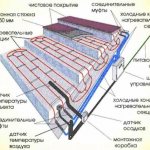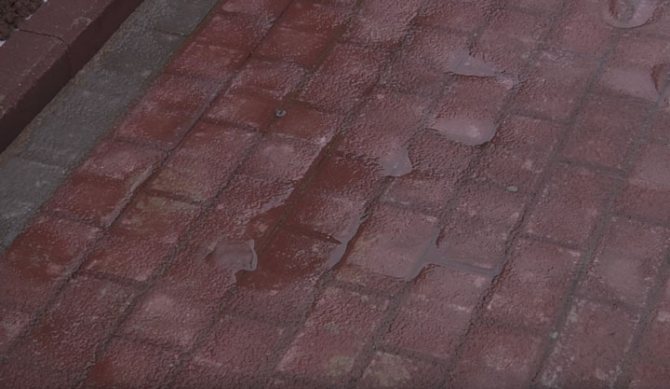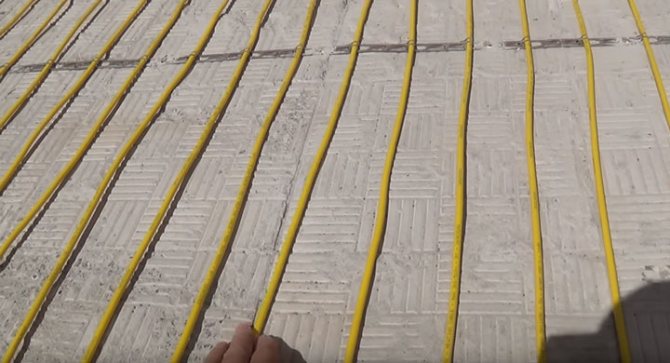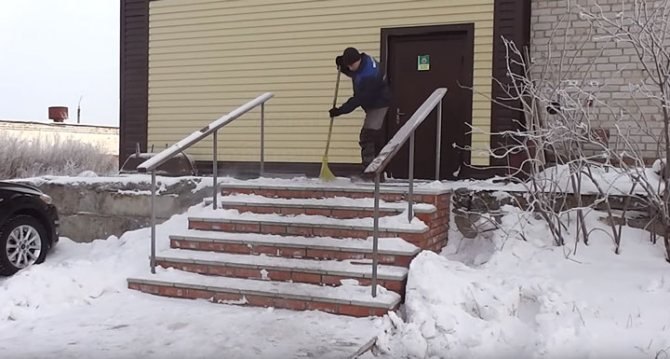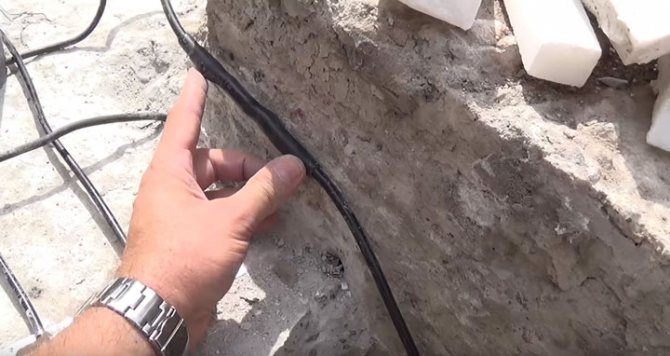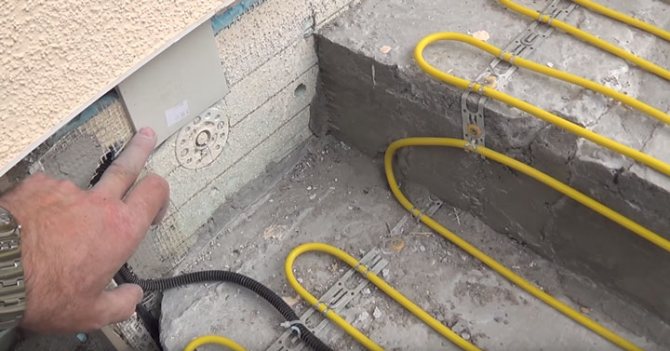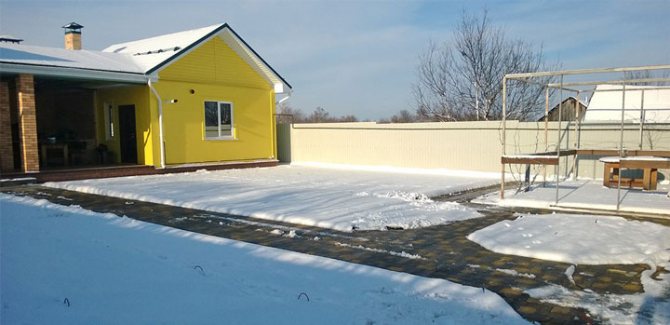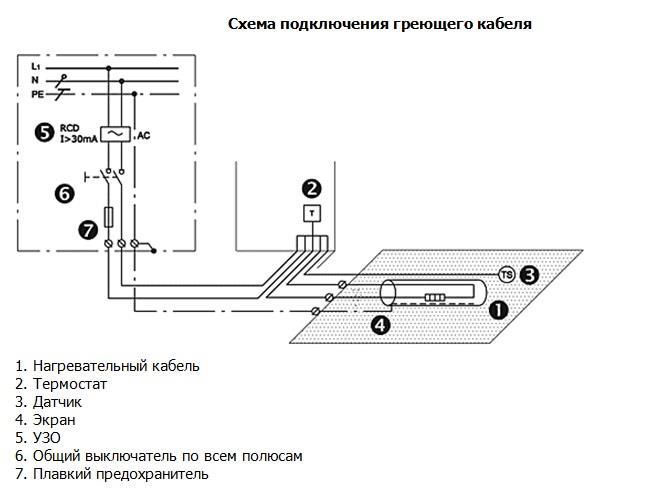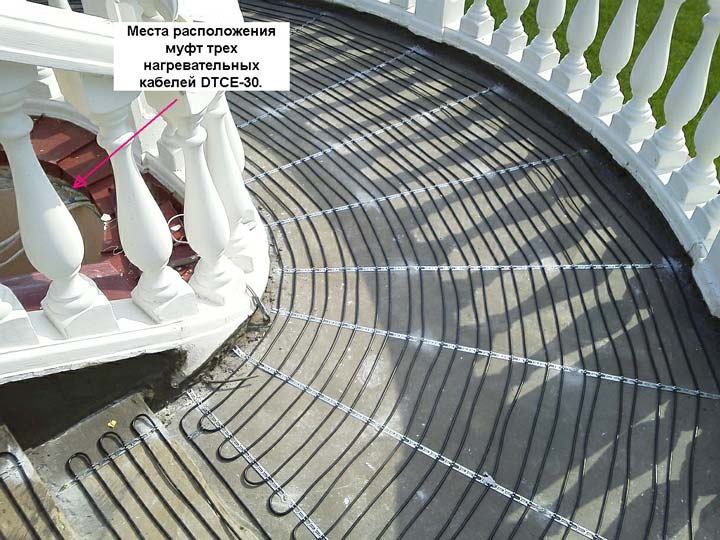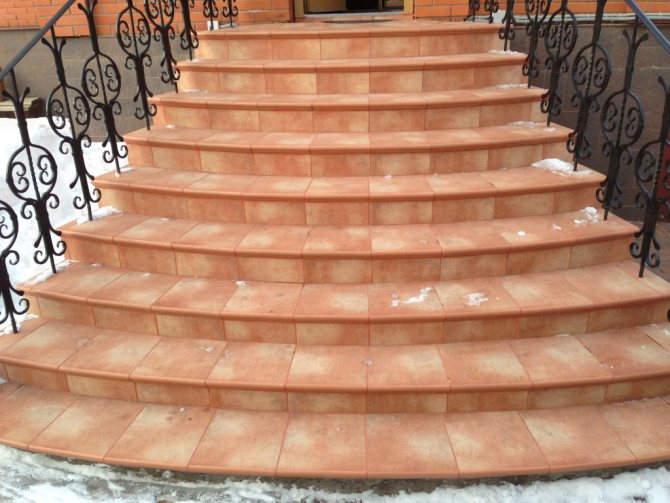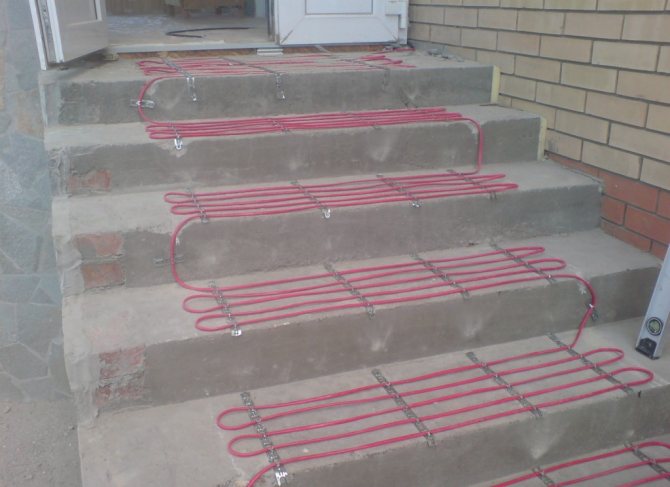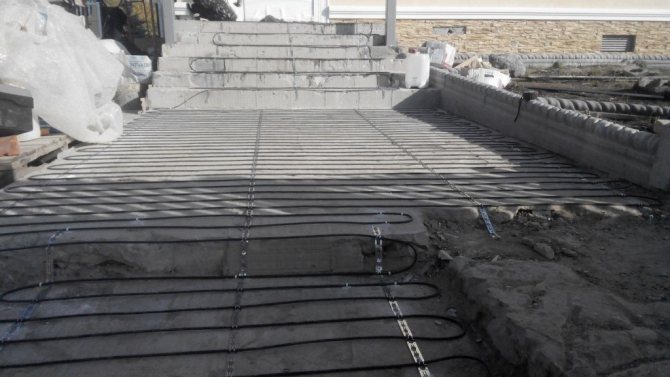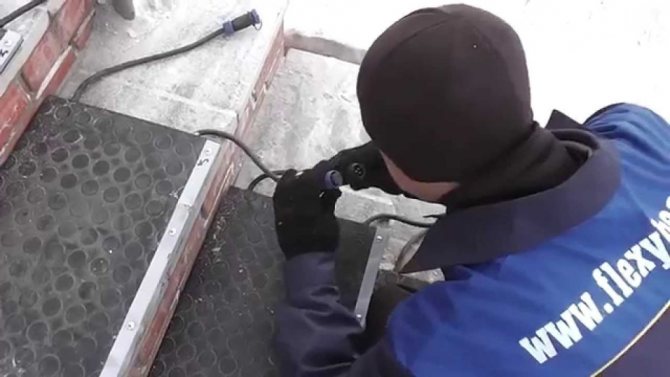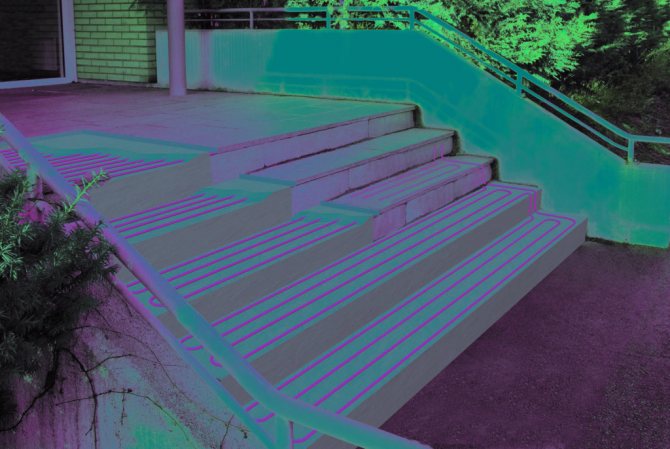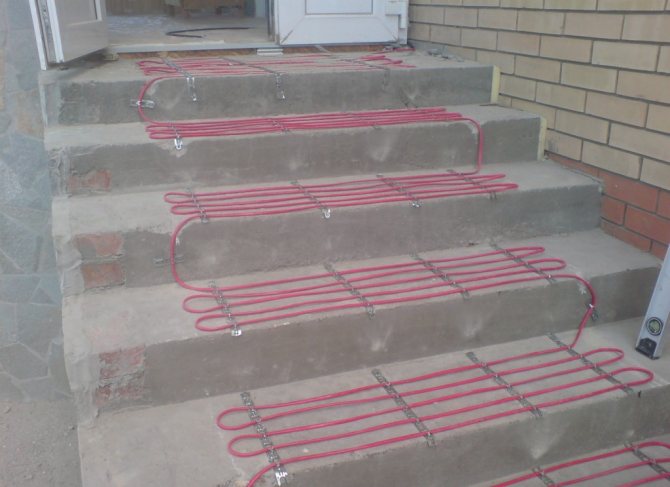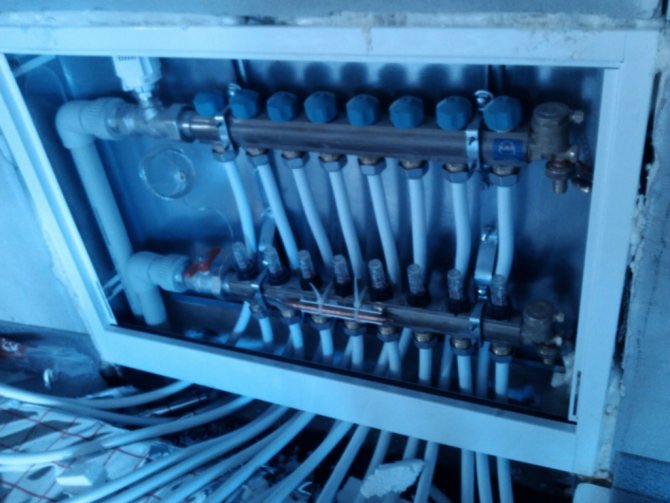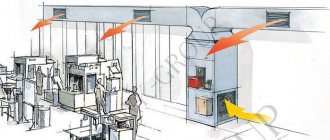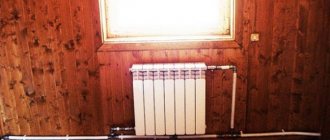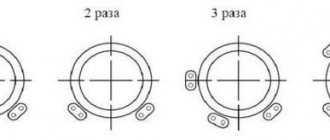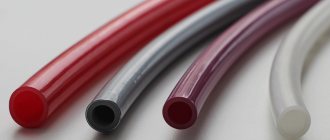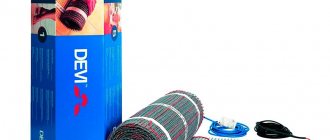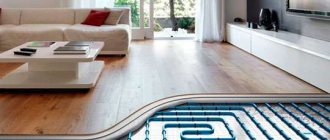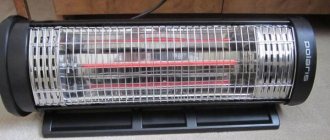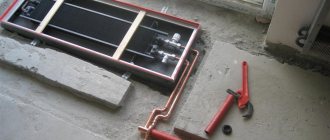Not only the owners of country houses, but also city dwellers are familiar with the problems that arise in winter with a sharp drop in temperature after a thaw. Especially traumatic are the steps in the entrances of residential buildings or other frequently visited institutions.
Not everyone will dare to take the icebreaker and knock the ice off the expensive covering of the steps, because the probability of its damage is high. Not everyone wants to leave the entrance and get into a puddle of melted ice from chemical reagents.
Therefore, most developers began to solve this problem using modern anti-icing technologies - built-in heating of street steps.
Types of thermal methods
At the moment, there are several methods that make it possible to equip external stage heating:
- the most common option is a heating cable;
- less common type is «water heating;
- a relatively new way is street heating with thermomats or infrared lamps.
As you can see, all known methods of arranging underfloor heating inside buildings have been adapted for outdoor heating structures, making them more resistant to harsh weather conditions.
When choosing a heating method, you should focus on the following indicators:
- average temperature indicators in winter and the amount of precipitation;
- porch dimensions and step parameters;
- under what cover the installation will be made.
Heating cable for heating steps, paths, porches, ramps
A heating cable of the CH-28 brand is used, which has a certain construction length. The basis is a resistive two-core heating cable. The constant specific heat dissipation power is 28 W / m. Prices for cable for heating steps.
| Area, m2 | Power, W | Length, m | Size, mm | Price, rub |
| SN-28-151 | 151 | 5,4 | 2054 rbl | select Buy |
| SN-28-185 | 185 | 6,6 | 2245 rbl | select Buy |
| SN-28-213 | 213 | 7,6 | 2689 rbl | select Buy |
| SN-28-300 | 300 | 10,7 | 3498 rbl | select Buy |
| SN-28-392 | 392 | 14 | 3811 rbl | select Buy |
| SN-28-521 | 521 | 18,6 | 4725 rbl | select Buy |
| SN-28-700 | 700 | 25 | 5639 rbl | select Buy |
| SN-28-924 | 924 | 33 | 6970 rbl | select Buy |
| SN-28-1176 | 1176 | 42 | 9006 rbl | select Buy |
| SN-28-1512 | 1512 | 54 | 10468 rbl | select Buy |
| SN-28-1848 | 1848 | 66 | 12791 rbl | select Buy |
| SN-28-2380 | 2380 | 85 | 15402 rbl | select Buy |
| SN-28-2912 | 2912 | 104 | 16707 rbl | select Buy |
| SN-28-3220 | 3220 | 115 | 17490 rbl | select Buy |
| SN-28-3696 | 3696 | 132 | 18587 rbl | select Buy |
| SN-28-4116 | 4116 | 147 | 20727 rub | select Buy |
Heating cable

Click to enlarge
Such a system can be mounted both under a concrete base and under a tiled masonry.
There are two popular types of this heating - rubber cable and cable mat.
They became widespread due to the ease of installation of the cable for any finish, ease of use, and the availability of elements for the system.
This system consists of the following basic elements:
- The heating system is the main part, which is represented in most cases by a self-regulating heating cable or, less often, a resistive heating option.
- Distribution group - covers electrical boxes, adjustment equipment, fasteners.
- Control group - temperature sensors and thermostats.
Experts call the optimal version of such a system a heat-resistant resistive heating cable for anti-icing of outdoor areas, which can be installed even under paving stones.
An example of calculating a porch heating system: steps and platforms
Electrical systems for melting snow and ice are effectively used to de-icing steps and entrances.When planning such a system, it is highly recommended to insulate the steps. The design power of the external stage heating system is 300-350 W / m2.
An example of calculating a heating system for steps and a platform above them
Object - 10 steps (width 100 cm, depth 32 cm, height 17 cm), entrance platform 100x100 cm.
Option 1. We choose a cable with a linear power of 18-20 W / m.
- We calculate the cable laying step: h = (18 W / m * 100 cm / m) / 350 W / m2 = 5.1 cm.
- The number of cable turns per rung: 32 cm / 5.1 cm = 6 (turns), i.e. for each step we will have 6 meters of cable (with a step width of 1 meter).
- Number of cable for 10 steps: 6 turns * 10 steps = 60 meters;
- The amount of cable that will be lowered for each step: 10 steps * 0.17 m = 1.7 meters
- Number of cable per top pad: 100 cm / 5.1 cm = 19 meters
- Heating cable total length: 60 m + 2 m + 19 m = 81 meters
- Total heated area: 10 steps * 1 m * 0.32 m + 1 m * 1 m = 4.2 m2
- The following cables are suitable for these requirements: Deviflex 18T 1360/1485 W, length 82 m - installed power density 1360 W / 4.2 m2 = 324 W / m2 (laying step 5 cm) Raychem T2Blue 20 W / m, 71 m, 1435 W - installed power density 1313 W / 4.2 m2 = 313 W / m2 (laying step 6 cm)
Option 2. We choose a cable with a linear power of 30 W / m.
- We calculate the cable laying step: h = (30 W / m * 100 cm / m) / 350 W / m2 = 8.5 cm.
- The number of cable turns per rung: 32 cm / 8.5 cm = 4 (turns), i.e. for each step we will have 4 meters of cable (with a step width of 1 meter). At the step, the laying step will be 7.5 cm.
- Number of cables for 10 steps: 4 turns * 10 steps = 40 meters;
- The amount of cable that will be lowered for each step: 10 steps * 0.17 m = 1.7 meters
- The amount of cable for the upper platform (laying step 8-10 cm): 100 cm / 9 cm = 10-11 meters
- Total length of heating cable: 40 m + 2 m + 11 m = 52 meters
- Total heated area: 10 steps * 1 m * 0.32 m + 1 m * 1 m = 4.2 m2
- The following cables are suitable for these requirements: 30MNT2-0480-040 - installed specific power 1440 W / 4.2 m2 = 342 W / m2 (3.5 meters of cable per step, laying step 7.5 cm, the rest to the upper platform - from 10 cm pitch) Raychem GM-2CW-50m - installed specific power 1355 W / 4.2 m2 = 322 W / m2 (3.5 - 4 meters of cable per step, 7.5 cm pitch, the rest on the upper platform - with a step of 10 cm) DEVI DTCE-30, 50 m, 1318/1440 W - installed specific power 1318 W / 4.2 m2 = 322 W / m2 (3.5 - 4 meters of cable per step, laying step 7.5 cm, the rest to the upper platform - in 10 cm increments)
Please note that these examples do not take into account the heating of the defrost path. In this case, ice may freeze on the site in front of the steps.
In addition to the heating cable, when installing the step heating system, you will need a mounting tape (for fixing the cable) and a thermostat to control the system. When calculating the length of the mounting tape, the step of laying the tape should be no more than 0.5 m. To control such a small system, it would be optimal to use a simple thermostat operating according to the ambient temperature (mounting on a DIN rail: DEVIreg 316, DEVIreg 330, TP-330; installation in a standard socket TR-140, terneo kt)
Heat transfer fluid circuit
This system is analogous to the construction of water floor heating in a room.
The process of installing such a system is more difficult, because it is planned in advance and is carried out during the construction of the building.
This is due to the fact that this type is connected to common sources of heating at home. The larger the heating area, the more effective this particular method is considered.
A circuit with a heat transfer fluid, as a system, has the following structure:
- pipelines for fluid movement;
- a heating boiler, which is a heat source;
- pump;
- control sensors and fasteners.
How are the steps heated?
A cable embedded in the porch for heating is connected to the power network. The system has a thermostat that turns it off when the set temperature is reached. Prefabricated staircases leading to the second floor in the open air are of a certain size. Installation of such a structure is not difficult.Such structures have affordable prices for most owners of residential buildings and public buildings.
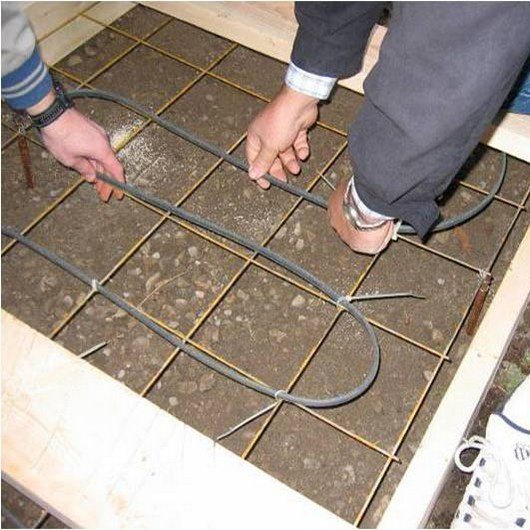

Laying and securing the cable to the surface
For heating a separate stage, its design provides for the laying of power cables. The installation of the contours is carried out by specialized companies, the photo shows the procedure for performing the work. A ladder of modular design, installed to climb to the second floor of a country house or summer house, rests on the interfloor ceilings. Prefabricated elements are connected with specially shaped brackets.
Infrared devices
Thermoelectric mats are also quite popular and effective type of outdoor staircase heating.
A carbon film placed on a heat-insulating base is the heating part of the system.
For greater safety, the base is covered with an additional shielding layer. The second layer is reflective, which is responsible for the distribution of heat fluxes.
Thermomats are small, separately located sections that are located inside a moisture-proof coating. They are equipped with thermostats.
Also, infrared lamps can be used as a method of heating and lighting. But this option is quite costly.
Infrared devices
Thermomats are sections or plates that have an infrared heating element inside. Thermomats can be purchased in standard sizes, or you can order the manufacture of a device of the required size. Thermomats have a protective coating and their own frame. There are two cable outputs from the device: input and output. They are connected to each other using connectors. You can connect them without difficulty and any additional tools. Cables can be laid in special boxes or arranged along the edges of the porch steps.
The main disadvantage of the infrared device is the following: most of the steps and the porch will be covered with thermomats. Thus, all the beauty of the porch cladding will be covered.
Thermomats do not completely solve the problem of icing on porch steps. To completely get rid of this problem, it is necessary to organize a normal stationary heating of the porch. Thermomats can only be used as a temporary solution to the problem.
Installation of heating systems
The most popular ways to decorate a porch is to pour the screed and tiling with a certain type of tile. How is the installation of heating in these cases.
At the first stage, a complete preparation of the surface should be carried out, which must be leveled and cleaned.
At the second stage, the selected type of heating is laid, which, subsequently, is fixed with mounting tape or fasteners. This process requires special attention and care so as not to damage the heating elements.
At the third stage, the cement screed is directly poured. During the preparation of the solution, it is necessary to avoid the formation of seals in the mixture, which ultimately can lead to the formation of air cells inside the screed, which will reduce heat transfer, or deformation of the cable.
The fourth step is to install sensors and control systems.
Read more about aging self-regulating cable
The last point means that if you make, for example, heating an open area with a Lavita GWS 40-2CR cable, with a rated power of 40 watts, and load it with work almost all the cold season (turn it on in autumn and turn it off in spring), then after 5-10 years the heating the cable will already deliver a lower rated power.
Due to the lower power of the heating cable, the time required to get rid of ice may increase, or there may not be enough heat output at all in the most severe frosts.
However, the depletion of the matrix resource occurs precisely during active work at low temperatures. This means that if we turn on the same cable much less often, periodically, when we need it, then after 15 years its rated power will drop slightly, and this will not affect its operation.


The left side of the porch is constantly heated with a resistive cable through the floor heating thermostat, the right side - with a self-regulating cable - forced switching on
So, for heating open areas, it is optimal to use a self-regulating heating cable in the following cases:
- Want to turn on the heating yourself when you need it, without a thermostat and sensors.
- You plan to use it periodically, from time to time.
- You want to save money and not pay for heating the track when you do not need it.
- You want to make a reliable, simple and safe system with a minimum of elements (no thermostats, sensors, control panel). By the way, you can also connect a self-regulating cable through a thermostat. You can first connect manually, and then, if desired, add heating controls in the form of a thermostat and sensors.
Resistive cable is used in autonomous heating systems for open areas, for example:
- You want the heating system to always work, regardless of whether you arrive today or in two weeks (control is usually performed by a weather station-thermostat that turns on the system, or only by an ambient temperature sensor, or in conjunction with a precipitation sensor).
- You want the porch and paths to be always free of snow, you do not want to turn on anything and even remember about the heating system.
- You are willing to spend money on electricity bills when the heating system is running frequently.
And in short: A self-regulating cable is more reliable (does not overheat), does not require a thermostat, can be plugged directly into an outlet or into a shield, but it weakens over the years with constant use. Resistive cable does not lose power over time, but requires the use of a thermostat, which is more demanding for laying and there is a risk of burnout in case something is wrong.
System features
So, many users have already been able to appreciate the effectiveness of this technology. And according to their reviews, it is cable heating that is the most effective and at the same time inexpensive.
Two cable options can be used here - resistive and self-regulating. Most often, the second option is chosen, since, despite its high cost in comparison with a resistive cord, in the end the first pays off in the first year or two.
Such a cord consists of special conductive cores, which are laid with a polymer together with impurities of coal dust. The cores are wrapped in a special matrix, which is enclosed in a special insulating material.
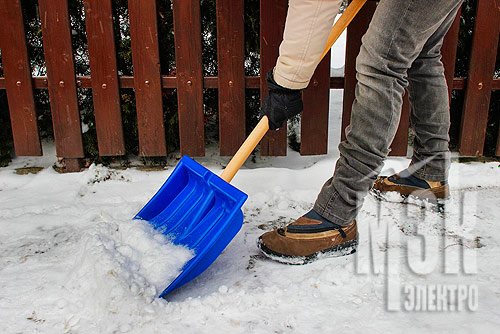

Heating of street steps and paths
It is worth noting that the cable system is suitable for almost any indoor or outdoor environment. And the installation is practiced under a variety of surfaces, including asphalt, paving slabs.
Moreover, you can adjust the degree of heating yourself. Now there is no need to fear that your relatives or loved ones will be injured when falling. And before leaving the site, it does not have to be cleared of snow drifts, while being late for an important conference.
Together with such a system, life will become much easier and safer. We are sure that everyone will be able to experience all the advantages of this technology, just order and install it on their site.
